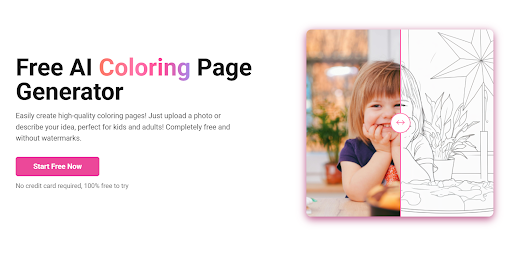When people hear “coloring pages,” they often imagine kids scribbling crayons over animal drawings—simple, repetitive, and maybe a bit boring. Seems unrelated to “design,” right? But is that really the case? Let’s take another look.
Every time you color, you’re actually doing some quiet “design training”—thinking about which colors to use, how to pair them nicely, where to color lightly, where to stay within the lines. You don’t need any formal background to start getting a feel for composition, proportion, and shapes.
Especially with AI coloring page generators, coloring isn’t just a “fill-in-the-blanks” exercise anymore—it becomes a little “co-creation experiment.” You input keywords, pick a style you like, and AI creates a unique line drawing for you. You’re not just a participant, but an active creator.
For kids, it’s a natural visual awakening; for adults, a fun and immersive creativity workout. No matter the age, this seemingly simple “coloring game” could be your first step into the world of design.
But when we say “everyone can create,” the real question pops up—without professional training, how do ordinary people understand and master the rules of visual expression? This is another value AI brings: it’s not just a tool, it can be an invisible “mentor.”
AI Is Becoming Our Visual Expression Mentor
Honestly, learning design used to be pretty tough—composition, color matching, layout, tons of jargon, and maybe you had to take classes or buy books. Now it’s different. With AI tools, you’re learning a lot just by doing.
For example, when you make a cover with AI tools, it automatically balances colors, centers images, and suggests fonts. Feels like an invisible teacher gently nudging you from behind, right? You might not feel like you’re “in class,” but your sense of design is quietly building up.
The best part? AI never judges. Not happy? Change it—10 times, 20 times—no one will frown. It’s like a super patient partner practicing with you until you find your groove.
And it’s thoughtful too: love manga style? It’ll give you more of that. Prefer minimalism? It learns your taste and tailors recommendations. This personalized feedback gets you better than traditional teaching.
You could say visual expression has never been this easy to pick up—it’s no longer just for the gifted, but a skill anyone can train. AI is turning design literacy from a few experts’ skill into a possibility for the many.
And this spread of expression skills is quietly changing how we interact with others and society.
From Personal Creation to Cultural Expression
As more people start expressing themselves visually, this expression isn’t isolated anymore—it’s forming a huge cultural ecosystem.
An AI-assisted kids’ coloring page isn’t just a parent-child bonding moment; it could become inspiring classroom material or a shared piece on social media, carrying cultural identity. Every “personal work” might be seen, referenced, copied, and become part of a collective story.
This phenomenon has sped up dramatically in just a few years. TikTok’s “template culture,” Instagram’s visual challenges, Pinterest’s creative collages… what we see is: visual expression has evolved from an individual art interest into a culture language everyone participates in.
AI’s role isn’t just helping more people “make stuff,” but more importantly—it lowers the barrier to “participate in culture.”
In the old media-dominated era, culture was one-way: pros created, the public received. Today, with image and video media, everyone is a creator, storyteller, even a micro-culture maker. That pic or short video you upload might shape a community’s visual trend.
Of course, this brings responsibility. We’re not just “consumers,” but culture shapers. Visual literacy isn’t just “can you draw,” but about what you want to say, whether your expression is powerful, and if it respects others’ contexts.
When AI gives us stronger “visual productivity,” it also means we need to learn to “express with heart.”
So, how do we really improve our visual literacy?
Visual Literacy: The Bridge Between Tech and Expression
There’s no one-size-fits-all answer, but I think it starts with two things: “seeing clearly” and “speaking clearly.”
“Seeing clearly” means you can spot the composition, rhythm, visual cues, and the relation between style and context in an image. Like, you can tell if it’s manga style or minimalist, and know which platform it suits and what story it tells.
“Speaking clearly” is how you express your ideas visually: which composition best conveys your intent, what colors create the mood you want, and whether your visual language matches your audience’s expectations.
Building these skills takes practice and reflection.
AI does offer a handy practice ground, but the key is: are we just mechanically “copy-pasting,” or consciously observing and tweaking? Every review after creation is a boost to your “visual language” skills.
When visual expression becomes something you can practice like writing, and learn like speaking, we truly enter the “image as native language” era. Visual literacy is no longer just for artists—it’s a survival skill for everyone in the digital age.
And that, perhaps, is the deeper meaning beyond AI coloring pages.







